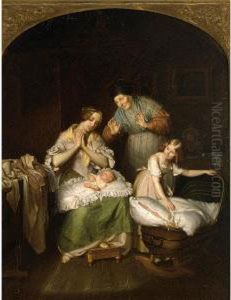Wilhelm Johann Schutze Paintings
Wilhelm Johann Schutze, also known as Wilhelm Schütze or Wilhelm Johann Schütze, was a German painter primarily known for his portraiture, genre scenes, and historical paintings. Born on October 23, 1830, in Pyritz, Pomerania (then part of Prussia, now Pyrzyce, Poland), Schutze developed an interest in the arts at an early age. His talent was evident, and he pursued formal education in the field of art.
Schutze studied at the Academy of Arts in Berlin, where he was influenced by the teachings of prominent artists of the time. He honed his skills in painting and developed a particular proficiency in capturing the likeness and character of his sitters in portraits. He also became skilled in creating scenes with historical and literary themes, which were popular during the 19th century.
Throughout his career, Wilhelm Johann Schutze exhibited his work in various venues, including the Berlin Academy exhibitions, where he gained recognition and respect among his peers. His works were appreciated for their attention to detail, composition, and use of color.
Despite his success as an artist, Schutze's life and career are not as well-documented as those of some of his contemporaries. This lack of extensive records has led to him being less known outside of specialist circles. Nevertheless, his contributions to 19th-century German art have been acknowledged by art historians, and his surviving works continue to be studied and appreciated for their aesthetic and historical value.
Wilhelm Johann Schutze passed away on February 13, 1900, in Berlin. His legacy is preserved in the paintings that remain, which provide insight into the style and culture of his era. While he may not have achieved the same level of fame as some of his peers, his work remains an important part of the tapestry of 19th-century European art.
